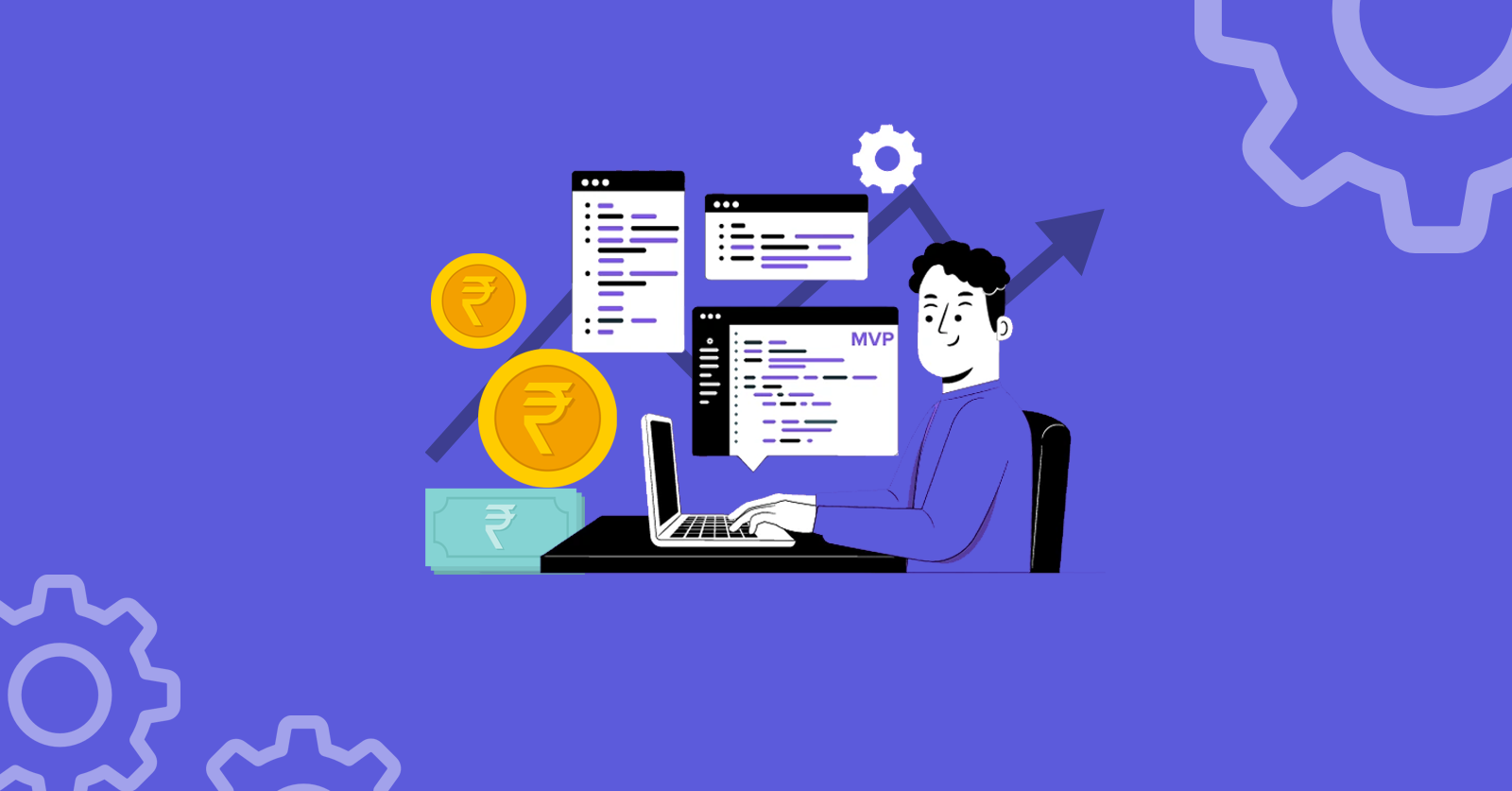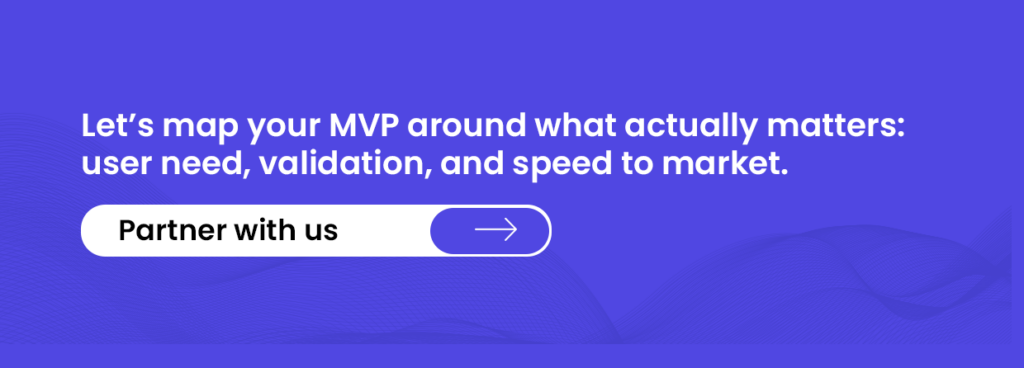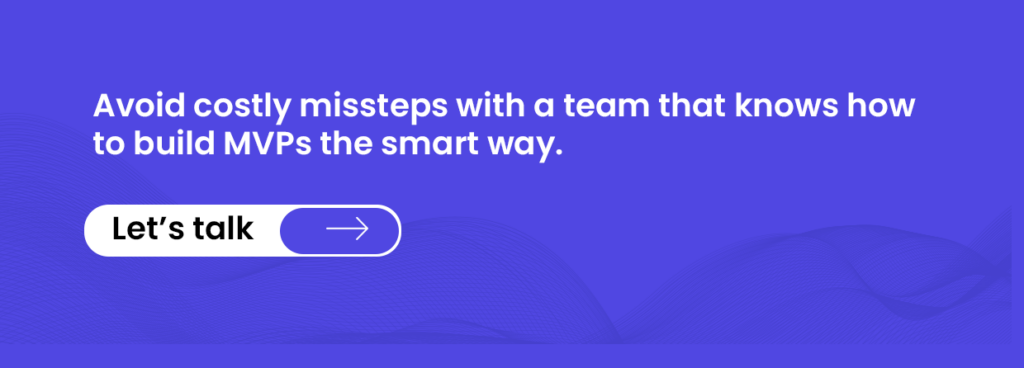
You’ve got the idea. You’ve done your research. You understand that building a Minimum Viable Product is the smart way to test the waters before going all in. But there’s one nagging question left – how much is this really going to cost me?
The truth? There’s no one-size-fits-all answer. Some MVPs get off the ground with just $10,000. Others need $100,000+. And while that sounds like a wide range, the difference comes down to more than just features and functions. It’s about what you’re building, who you’re building it with, and how smartly you plan the journey.
In this article, we’ll break down the real cost factors – from design and development to team structure and tech stack choices – so you can budget with clarity and confidence, not guesswork. Whether you’re bootstrapping or backed by early investors, this guide will help you understand where your money goes – and how to make every dollar count.
Why Building an MVP is Non-Negotiable if You’re Serious About Product Success
Let’s be real – building a full-fledged product right out of the gate is a high-stakes gamble. You might get it right, but chances are, you’ll sink thousands (sometimes hundreds of thousands) into features that no one actually wants, into workflows that don’t convert, or into assumptions that break down the moment real users enter the picture.
An MVP flips that equation. It makes learning your first priority – not building.
At its core, a Minimum Viable Product helps you answer the most important question in your startup’s early life: Is this something people truly need, and are they willing to engage with it? You don’t need to build a perfect app to find that out. You need to build just enough to test your core value proposition – nothing more, nothing less.
Think of an MVP as your launch runway, not a shortcut.
You’re not skipping product development – you’re doing it smarter. With a focused MVP, you:
- Validate your riskiest assumptions early – before spending heavily on development.
- Get your product in front of real users faster to test usability, demand, and stickiness.
- Collect high-value feedback from early adopters who help shape what comes next.
- Attract investors or partners with real data, not just ideas or pitch decks.
- Build internal clarity – about your roadmap, priorities, and customer expectations.
Even the most iconic startups – Airbnb, Dropbox, Uber – began with scrappy MVPs. Not because they couldn’t build more, but because they knew better than to build too much too soon.
Here’s what an MVP isn’t:
It’s not a “cheap version” of your dream product. It’s not a shortcut to market. And it’s definitely not a throwaway prototype. A strong MVP is a concentrated, purpose-built version of your product’s core promise, designed to prove (or disprove) that you’re solving the right problem in the right way.
In short, if you’re building a startup, you’re also building uncertainty. An MVP doesn’t eliminate that – but it does make it manageable, measurable, and directionally useful. And in a world where time, funding, and user attention are your scarcest resources, that’s not just valuable – it’s essential.

What Really Goes into the Cost of Building an MVP?
If you’ve Googled “MVP development cost,” you’ve probably seen numbers ranging from $10,000 to over $150,000. So, what gives?
The truth is, MVP cost isn’t just about lines of code or hours of work. It’s a composite of choices you make – what industry you’re in, how complex your product is, the tech powering it, and who’s building it.
Let’s break it down.
Cost by Industry/Sector
The industry you’re building for has a significant influence on how much your MVP will cost. Some sectors demand greater regulatory compliance. Others require highly interactive features, stronger infrastructure, or complex user journeys. Even if the core app structure is similar, the context in which it’s used can double the build time – and the price tag.
Here’s how MVP costs vary across common startup sectors:
| Industry | MVP Cost Range (USD) | Key Cost Drivers |
| Fintech | $50,000 – $150,000 | High data security, compliance, integrations |
| Healthtech | $60,000 – $200,000+ | HIPAA compliance, complex user roles, EMR integration |
| E-commerce | $20,000 – $60,000 | Product catalog, payments, user flows |
| SaaS (B2B) | $30,000 – $80,000 | Multi-tenant logic, dashboards, onboarding |
| Social Media/Marketplace | $25,000 – $70,000 | Real-time features, messaging, profiles, moderation |
| Edtech | $30,000 – $90,000 | Multimedia content, assessments, user hierarchy |
Note: These are rough averages. A fintech MVP with just one feature might cost less than a full-blown edtech MVP with live classrooms.
Cost by Development Stage
When it comes to calculating MVP cost, understanding the development journey is just as important as knowing the final price tag. Each stage – discovery, design, development, testing – adds structure and depth to your product. And each one comes with its own cost considerations. Skipping or undervaluing any of these phases can lead to costly rework later. Below is a breakdown of how most MVP budgets are distributed across key development stages, helping you plan for what’s essential and allocate funds more strategically.
| Stage | % of Total Budget | What’s Included |
| Product Discovery & Scoping | 10–15% | Feature prioritization, user stories, UX flows |
| UI/UX Design | 15–20% | Wireframes, clickable prototypes, design systems |
| Frontend Development | 20–25% | Web/mobile interfaces, responsive design |
| Backend Development | 30–40% | APIs, databases, server logic |
| QA & Iteration | 10–15% | Testing, bug fixes, refinements |
Cost by Tech Stack & Feature Complexity
Not all MVPs are created equal – and the technologies you choose to build with can make a big difference in your final costs. Some tech stacks are faster to develop with, while others offer long-term scalability but come with higher upfront investment. Beyond that, the complexity of your features – from AI-driven personalization to real-time chat or video streaming – can drastically affect how many developer hours are needed. It’s not just about what your app does; it’s about how much logic, infrastructure, and integration it takes to make it work. The more ambitious your feature set, the more you should be prepared to invest. Here’s how common features and technologies can influence MVP costs.
| Feature/Tech | Added Cost Impact |
| AI/ML Integration | +$10,000–$40,000 |
| Real-time Chat/Notifications | +$5,000–$15,000 |
| Payment Gateway | +$3,000–$8,000 |
| Video Streaming | +$10,000–$25,000 |
| Third-party Integrations (e.g., Stripe, Salesforce) | +$2,000–$10,000 |
| Cross-platform Support (iOS + Android) | +30–50% increase |
The more moving parts, the higher the development hours – and ultimately, the bill.
Who You Hire Also Shapes the Cost
Even with the same features and scope, your MVP’s cost can swing dramatically depending on who’s building it. Hiring a couple of freelancers on a tight budget will look very different from working with a top-tier U.S. agency – or building your own in-house team. Each option comes with trade-offs in cost, speed, communication, and long-term scalability. Some founders prefer close control and day-to-day collaboration; others prioritise speed and affordability. Understanding the strengths and limitations of each team model is key to making the right hiring decision – and budgeting accurately for it. Here’s how different hiring setups typically impact MVP development costs.
| Type of Team | Cost Range (USD) | Pros & Cons |
| Freelancers | $8,000 – $30,000 | Low cost, high risk of delays/inconsistency |
| Offshore Dev Agency | $15,000 – $50,000 | Affordable, timezone/culture mismatch risk |
| US-based Dev Agency | $50,000 – $150,000+ | High reliability, higher cost |
| In-house Team (Early Stage) | $100,000+/year | Full control, not viable for MVP alone |
Pro tip: Many founders go hybrid – hire a product consultant, outsource dev, and keep strategy in-house.
Hidden Costs You Should Plan For
Beyond the obvious development and design expenses, there are several behind-the-scenes costs that tend to sneak up on first-time founders. These aren’t always included in initial quotes from freelancers or agencies, but they’re essential for a functional, secure, and maintainable MVP. From hosting and third-party tools to ongoing maintenance and user analytics, these “invisible” expenses can add 10–20% to your budget if you’re not prepared. Here’s a list of common hidden costs you should factor into your MVP planning from day one.
- Project management tools (e.g., Jira, Notion)
- Hosting and cloud services (AWS, Firebase)
- Post-launch maintenance (~10–20% of initial cost annually)
- Analytics setup (e.g., Mixpanel, Hotjar)
Mistakes That Can Quietly Blow Up Your MVP Budget
Many MVPs go over budget not because of ambitious features or bad developers – but because of avoidable missteps made early in the process. These mistakes often creep in during planning, communication, or execution, and the financial consequences pile up before you realise what’s happening.
Here are some of the most common (and costly) pitfalls to avoid:
1. Building for the “ideal version” instead of the core problem
One of the easiest ways to overspend is by cramming too much into your first version. Founders often get excited and try to include every feature they’ve imagined for the product’s future. But an MVP isn’t meant to impress everyone – it’s meant to test one core idea. Adding “nice-to-haves” at this stage is a fast track to scope creep and budget overruns.
2. Skipping the discovery phase or rushing through planning
It might feel like a waste to spend time mapping flows and writing user stories when you just want to build. But skipping the planning phase leads to vague requirements, back-and-forth changes, and unclear handoffs – all of which cost time and money. A well-scoped MVP always costs less in the long run.
3. Hiring cheap instead of smart
Choosing the lowest-cost freelancer or agency often seems like a win – until the deliverables miss the mark, deadlines slip, and you have to redo everything. You don’t need the most expensive team out there, but you do need a partner who understands lean product thinking and startup realities. Quality up front prevents costly rework later.
4. Ignoring technical debt
A fast-and-loose MVP build might seem fine for launch, but if your team cuts too many corners, the codebase can become unscalable or unstable. That means your “quick win” turns into a total rebuild when it’s time to scale. Be lean – but don’t be reckless.
5. Underestimating post-launch iteration
Your MVP doesn’t end at launch. Real users will point out bugs, blockers, and unexpected behaviour. If you haven’t budgeted for post-launch refinement, you risk stalling momentum at a critical moment. Always keep room for a few more sprints after you go live.

How to Reduce MVP Costs Without Sacrificing Quality
Cutting costs doesn’t have to mean cutting corners. The smartest founders know how to be lean without being cheap – focusing on what matters now and deferring the rest until after validation.
Here’s how to stretch your budget without compromising on the product’s value:
1. Nail down the problem before writing a single line of code
The most affordable MVPs are the ones that are scoped with clarity. Talk to potential users. Map the pain points. Define the one problem you’re solving and the smallest possible solution that makes it usable. This prevents wasteful rework – and it’s free.
2. Stick to one platform at launch
It might be tempting to go live on iOS, Android, and web at once – but unless your users absolutely demand it, pick the one channel where your audience is most active. Cross-platform development or progressive web apps (PWAs) can help you stay versatile while managing cost.
3. Use open-source tools and pre-built components
You don’t have to reinvent the wheel. UI libraries, authentication modules, admin templates, and third-party APIs can save weeks of effort – without sacrificing polish. Just make sure your team knows how to integrate them well.
4. Outsource strategically
Hiring a full in-house team for an MVP can burn through your runway fast. A hybrid model – where you keep product strategy internal and outsource development to a trusted partner – can give you speed and flexibility at a much lower cost.
5. Prioritise features with a value-first lens
Don’t build something just because it’s “standard.” Focus on the features that prove your product works, not the ones that make it feel complete. For example, a simple manual onboarding workflow might be enough early on – no need to automate everything right away.
6. Plan for post-launch learning, not perfection
Aim for usable, not flawless. What you learn after launch will be more valuable than any guess made in pre-launch meetings. Allocate budget for those early iterations – it’s often where real product-market fit begins to take shape.
An MVP is a test, not a final product. The goal isn’t to launch big – it’s to launch smart. The more ruthlessly you focus on validation, the more cost-effective (and strategically sound) your MVP will be.

What Makes CodingWorkX the Right Choice for Your MVP Development Needs
At CodingWorkX, we know what it’s like to launch something from scratch – when timelines are tight, budgets are limited, and every decision feels like it carries the weight of your entire startup. That’s exactly why we don’t just offer development services; we bring startup-savvy product thinking to the table from day one.
Unlike traditional development shops that try to upsell features or overengineer early builds, we approach MVPs with a razor-sharp focus: what do you need to validate your idea, engage early users, and create momentum for what comes next? Nothing bloated. Nothing built for the sake of building.
Our team blends product strategy with tech execution. We don’t just ask what you want built – we challenge assumptions, help you prioritise, and pick the right tools and architecture that balance cost, scalability, and speed. Whether you’re in fintech, SaaS, healthcare, or launching something entirely new, we’ve likely seen a version of your challenge – and know how to avoid the common (and costly) pitfalls.
What makes working with us different is the way we work with you. We believe in complete visibility, fast feedback loops, and weekly deliverables that keep your vision and progress in sync. There’s no mystery, no hand-holding needed, and no wasted effort. Just smart execution from a team that knows what early-stage products demand.
If you’re looking for a partner who can think like a founder and build like a CTO, CodingWorkX is ready to help you take your idea from pitch deck to working product – with clarity, urgency, and purpose.
FAQ
Q. How much does it cost to build an MVP in 2025?
Ans. The cost to build an MVP in 2025 typically ranges from $20,000 to $150,000, depending on your industry, feature complexity, tech stack, and who you hire. A lean SaaS dashboard might land closer to $25K, while a healthcare or fintech MVP with security and compliance requirements could be six figures. At CodingWorkX, we help scope the MVP strategically – so you invest where it matters most.
Q. What factors influence MVP development cost?
Ans. Several variables impact your final cost:
- Scope and number of features
- Industry-specific requirements (like HIPAA or PCI compliance)
- Design complexity and user experience expectations
- Tech stack and integration needs
- Team structure (freelancers vs. agency vs. in-house)
- Timeframe and launch deadlines
Even small decisions like whether to support both iOS and Android at launch – can affect your budget significantly.
Q. How is MVP pricing different from full product development?
Ans. MVP pricing is focused on speed, learning, and validation, not completeness. Instead of building every feature you’ve imagined, you’re launching with just enough to test your core idea. That makes MVPs faster and cheaper than full builds, but also more focused. A full product includes scalability, automation, advanced user flows, and refined UX – none of which are essential for a first test of market fit.
Q. How does CodingWorkX estimate MVP development budgets?
Ans. We start with a discovery and scoping session to understand your product vision, users, and desired outcomes. From there, we map user flows, prioritise features, and break the project into phases. You’ll get a clear estimate based on effort, tech stack, and milestones – no vague ranges or surprise charges. We believe in transparency from day one so you can budget with confidence.
Q. How long does it take to build an MVP?
Ans. Most MVPs take 8 to 16 weeks, depending on complexity. A simple, single-platform app with basic features might take 6–8 weeks, while more advanced products with integrations or real-time components can take 3–4 months. Our process is sprint-based, so you’ll start seeing working modules early and have the flexibility to iterate as you go.
